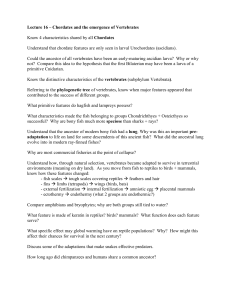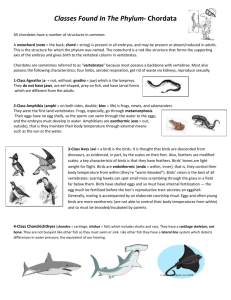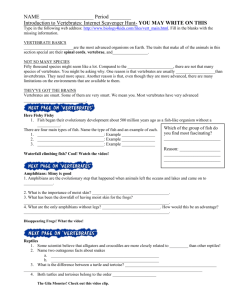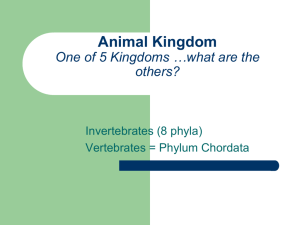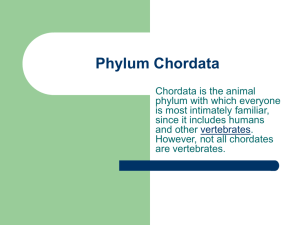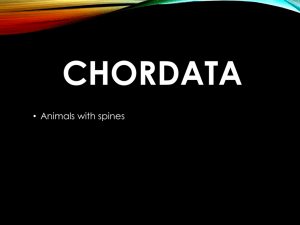Animal Kingdom - Phylum Chordata - STUDY NOTES
advertisement
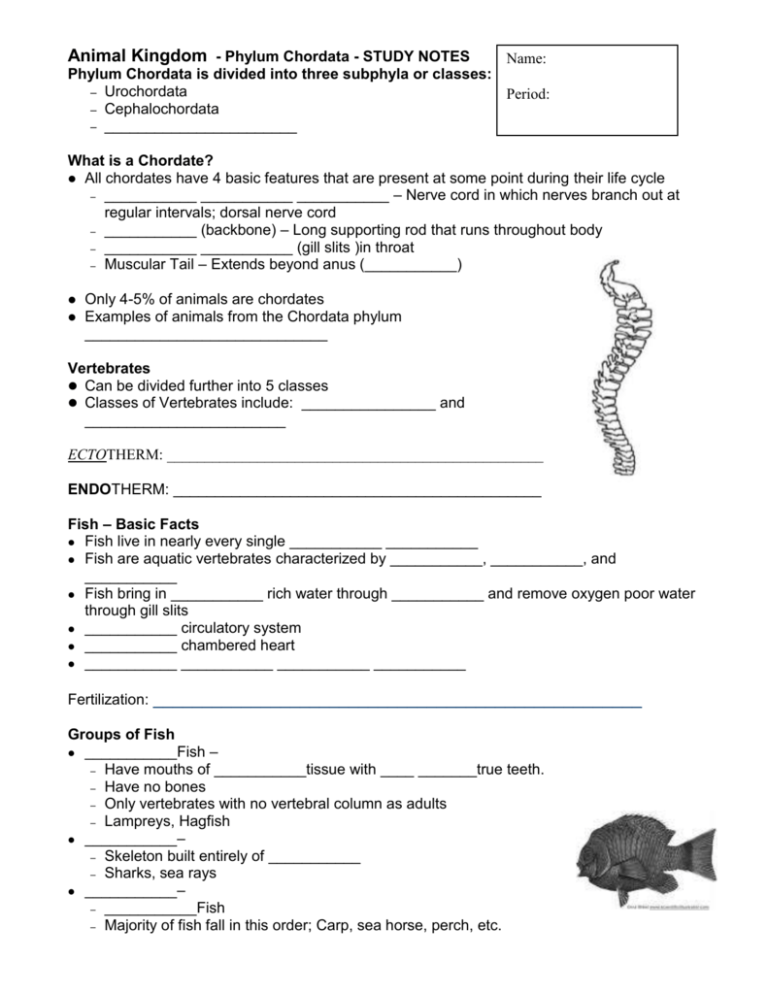
Animal Kingdom - Phylum Chordata - STUDY NOTES Name: Phylum Chordata is divided into three subphyla or classes: – Urochordata Period: – Cephalochordata – _______________________ What is a Chordate? All chordates have 4 basic features that are present at some point during their life cycle – ___________ ___________ ___________ – Nerve cord in which nerves branch out at regular intervals; dorsal nerve cord – ___________ (backbone) – Long supporting rod that runs throughout body – ___________ ___________ (gill slits )in throat – Muscular Tail – Extends beyond anus (___________) Only 4-5% of animals are chordates Examples of animals from the Chordata phylum _____________________________ Vertebrates Can be divided further into 5 classes Classes of Vertebrates include: ________________ and ________________________ ECTOTHERM: __________________________________________________ ENDOTHERM: ____________________________________________ Fish – Basic Facts Fish live in nearly every single ___________ ___________ Fish are aquatic vertebrates characterized by ___________, ___________, and ___________ Fish bring in ___________ rich water through ___________ and remove oxygen poor water through gill slits ___________ circulatory system ___________ chambered heart ___________ ___________ ___________ ___________ Fertilization: __________________________________________________ Groups of Fish ___________Fish – – Have mouths of ___________tissue with ____ _______true teeth. – Have no bones – Only vertebrates with no vertebral column as adults – Lampreys, Hagfish ___________– – Skeleton built entirely of ___________ – Sharks, sea rays ___________– – ___________Fish – Majority of fish fall in this order; Carp, sea horse, perch, etc. The Swim Bladder: _________________________________________________________ _________________________________________________________________________ Basic Fish Anatomy Amphibians – Basic Facts Amphibian = “_________ ____________” Live in both _________ and ____________ Most larvae are fishlike; adults are terrestrial carnivores Larvae respire through skin/gills; Adults use lungs Descendants of ancestral organisms that evolved some, not all, adaptations for life on land First appeared 360 million years ago ___________fertilization ___________circulatory system ___________chambered heart Groups of Amphibians ___________– – Long bodies and tails – Adults are carnivorous – Usually live in moist woods ___________and ___________– – Lack tails – Frogs have long legs and are usually tied to water – Toads have shorter legs and not as closely tied to water ___________– – Legless animals that burrow in moist soil – Have fishlike scales Reptiles – Basic Facts All reptiles have: – __________________________ – helps prevent loss of body water in dry environments – ____________________eggs – first animals to develop amniotic eggs that didn’t need to be deposited in water Respire using _________________ __________________ Fertilization; Most are egg-laying _________________ – cannot internally regulate body temperature; cannot live in cold climates Behavior controls body temp. (swimming, burrowing, basking, etc.) __________________ circulatory system; double loop; Heart = two atria/one or two ventricles Groups of Reptiles _______________ – Shells – Beaks (no teeth) ________________________ (Squamates) – Shed Skin – Jointed jaws/ skulls ___________________ – Large Snout- Big teeth – Powerful tail – Semi-aquatic ____________________ – Only 2 species (New Zealand)- most have become extinct Birds – Basic Facts Nearly ________________ modern bird species Birds are closely related to _____________________ (scales on legs) Have outer covering made of __________________, two legs used for walking or perching, and forelimbs modified into ____________________ Feathers separate birds from all other animal species Feathers provide insulation for ________________________; can generate body heat ___________________ bones- lighter for flight ________________________ adapted to type of food they eat Highly efficient ___________________________ system; lungs only exposed to Oxygen rich air ____________________ fertilization; _______________________ eggs; many mate for life Bird Groups Neorinthes (Modern birds) have 27 Orders of different bird groups (ex: ducks, grouse, pigeons, pelicans, hawks, hummingbirds, owls, woodpeckers, and perching birds, etc.) Mammals – Basic Facts First true mammals appeared ___________ million years ago Mammals flourished after dinosaurs became extinct – 65 million years ago Basic characteristics – ________________ – _____________________ glands – produce milk to nourish young – Breathe air – _________________chambered heart – _____________________ – can generate own body heat – ___________________ fertilization; ________________________ Mammal Groups ________________________ – Lay eggs – Duck-billed platypus and anteater ________________________ – Birth live young and develop in a pouch – Kangaroos, koalas, opposums, etc. ________________________ – Young fully develop inside mother – Nourished by a placenta

